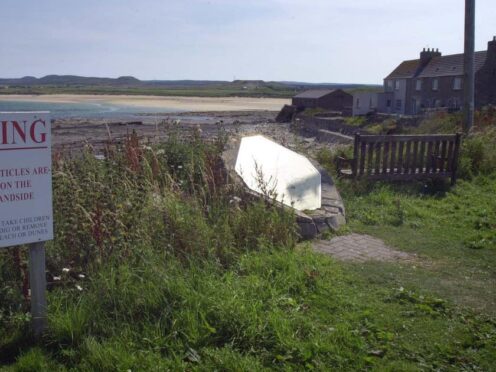A judge has ruled that a woman who died from cancer was “negligently exposed” to asbestos when she washed her husband’s dirty work clothes more than 40 years ago.
In the first case of its kind in Scots law, Lady Carmichael concluded that Adrienne Sweeney was exposed to the substance when she laundered her hubby William’s clothes in the 1960s.
Mr Sweeney spent the decade working as a fitter at a boiler making factor in Renfrew.
After coming home from work, Mr Sweeney – who died in 2008 – would “cuddle” Mrs Sweeney whilst wearing overalls which were covered in dust and dirt.
She would then wash his clothes, which the court has ruled exposed her to asbestos.
Lady Carmichael yesterday said this exposure “materially increased” the risk of Mrs Sweeney contracting mesothelioma – the illness which claimed her life in 2015.
In a written judgement, the judge ruled that Mr Sweeney’s former employers – Babcock International – should pay his and his wife’s surviving relatives damages, which were undisclosed.
Lady Carmichael wrote: “This is, so far, as I can tell, the first case in this jurisdiction in which a proof has taken place dealing with secondary exposure, that is, exposure to someone in the home of an an employee, alleged to have caused mesothelioma in a secondary victim.
“I am satisfied that the defenders failed to reduce the risk to the deceased. There was no safe known level of exposure.
“For the reasons set out, I am satisfied that the defenders negligently exposed the deceased to asbestos and materially increased the risk that she would develop mesothelioma.”
The case was heard before the court last year.
Mrs Sweeney’s children Kay Gibson, 54, of Paisley, Jan Sweeney,52, of Moscow, Ayrshire, and William Sweeney,50, of Beith, also Ayrshire, originally sued Babcock for £50,000 as individuals.
Mrs Gibson, also sought £200,000 as the executrix of her estate with lesser sums sought by other family members.
Prior to dying aged 75, Mrs Sweeney gave a statement to a legal firm’s representative detailing her employment history and that of her late husband William.
The firm’s employee Joe McCluskey told the court that Mrs Sweeney “knew” there was asbestos dust on his overalls.
In her judgement, Lady Carmichael noted that lawyers acting for Mrs Sweeney’s family had argued Mr Sweeney’s employers should have done more to prevent his wife being exposed to the substance.
Lawyers for Babcock argued that the evidence to prove Mrs Sweeney’s claims was insufficient. They argued that it wasn’t clear as to whether and to what extent Mr Sweeney was exposed to asbestos at the boiler maker factory.
Advocate Neil Mackenzie told the court that there was nothing to suggest that warnings given to shipyards were given to factories such as boiler plant in Renfrew.
But Lady Carmichael ruled in favour of the family.
She added: “I accept that Mr Sweeney brought dusty clothes home with him. Whether the deceased had any basis in her own knowledge or from discussion with Mr Sweeney for her statement that the clothing had asbestos dust on it, I do not know.
“I accept that the deceased shook out and washed Mr Sweeney’s work clothes in the manner described in her statement. Her statement is imprecise as to the frequency with which she did so, but I infer from what she said that this was a regular occurrence, carried out throughout the different seasons and, on the balance of probabilities, at least weekly.
“I infer that the defenders knew or ought to have known that work clothes would be cleaned at home given that they did not provide clean clothing themselves.”
Mrs Sweeney’s daughter Kay Gibson said: “We are pleased that our case against Babcock International was successful. Most importantly this gives our late mother the justice she wanted in life and that we sought on her behalf after her painful and unnecessary premature death.
“Our loving mother like so many other women in Scotland in the late 1960’s and early 1970’s supported her family by caring for her children and washing her husband’s overalls when he returned from a hard day’s work for employers who used deadly asbestos.
“These women like our mother were unaware how unsafe it was to be handling the asbestos dust that came from these work clothes or of the contamination risk to their own and their families’ lungs. We her children await to see if we will suffer the same fate. Babcock International have not won their case but is it wrong that ordinary bereaved families still have to individually battle the might of global corporations for justice for their late relatives in such situations.”










